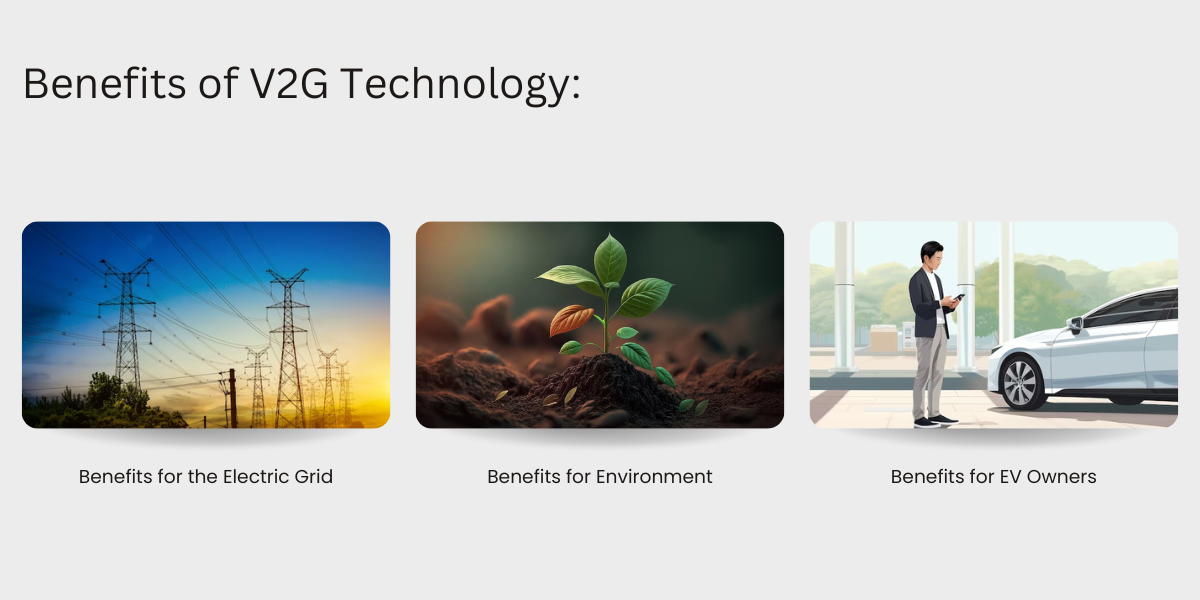
Role of V2G technology in the modern world
Vehicle-to-Grid (V2G) technology is a smart charging technology that allows electric vehicles (EVs) to give back to the power grid by pushing energy back to the grid from the battery of an EV. V2G technology enables EV batteries to be discharged based on different signals, such as energy production or consumption nearby.
V2G is a subset of a broader project known as vehicle-grid integration. V2G installation necessitates a complex set of smart technology. To analyse overall system demand at any one time, charging stations must be outfitted with software that connects with the central grid.

Benefits for the Electric Grid: V2G technology can help balance the grid by providing additional power during peak demand periods. It can also help reduce the need for expensive grid infrastructure upgrades.
Benefits for the Environment: V2G technology can help reduce greenhouse gas emissions by enabling EVs to store renewable energy and feed it back into the grid when needed.
Benefits for EV Owners: V2G technology can provide EV owners with additional revenue streams by allowing them to sell excess energy back to the grid. It can also help extend the life of EV batteries by reducing the number of charge cycles required.
Examples of V2G Projects and Initiatives Around the World:
In North Carolina, a demonstration of two-way V2G technology showed the economic potential for using EVs as a grid resource.
United Kingdom: In the UK, programs and strategies to assist in EV adoption were implemented, including V2G technology.
Australia: Researchers at the Australian National University produced a comprehensive review of international V2G projects.
Europe: The demand response markets in Europe are growing at over a 20% growth rate, and V2G is one of the most promising tools in the demand response markets.
MIT: Researchers at MIT evaluated the opportunities for V2G-enabled EVs and PHEVs to realize revenues from the regulation market that offset operating costs, making them more economically viable.
MDPI: Researchers at MDPI evaluated the impact of V2G technology on the power grid and battery, highlighting the recent research works and policies to address the challenges with V2G.
V2G technology is a promising tool that can help balance the grid, reduce greenhouse gas emissions, and provide additional revenue streams for EV owners. Although V2G is still a project-based business, it is projected to grow to over $5 billion by 2024
How does V2G technology benefit the electric grid in terms of stability and reliability?
V2G technology benefits the electric grid in terms of stability and reliability in the following ways:
Grid Balancing: V2G technology helps balance the grid by providing additional power during peak demand periods. EVs can respond to signals from the grid and adjust their charging and discharging patterns to help balance the grid and ensure its stability and reliability. This reduces the risk of blackouts and other grid disruptions, leading to a more reliable and efficient electricity supply.
Frequency and Voltage Regulation: V2G technology can assist in regulating the frequency and voltage of the grid. EVs can provide grid services like frequency regulation and voltage support by adjusting their charging and discharging patterns. This helps maintain the stability and reliability of the grid by ensuring that the frequency and voltage levels remain within acceptable limits.
Integration of Renewable Energy: V2G technology acts as a buffer that enables the integration of more renewable energy sources, such as wind and solar, into the grid. EVs can store excess renewable energy and feed it back into the grid when needed, helping to smooth out the intermittent nature of renewable energy sources. This reduces the need for fossil fuel-powered plants and promotes the expansion of renewable energy.
Reduced Grid Infrastructure Costs: By utilizing V2G technology, the need for expensive grid infrastructure upgrades can be reduced. EVs can provide additional power during peak demand periods, reducing the strain on the grid and potentially avoiding the need for costly infrastructure investments
V2G technology benefits the electric grid by improving stability and reliability through grid balancing, frequency and voltage regulation, integration of renewable energy, and reducing grid infrastructure costs. By leveraging the power of EVs, V2G technology contributes to a more sustainable and resilient electric grid system.

